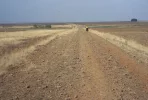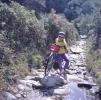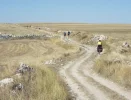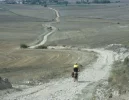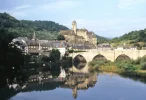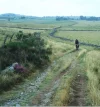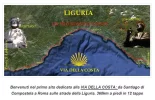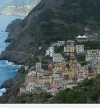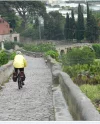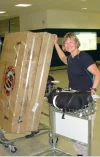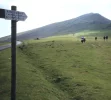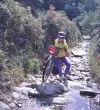Camino Frances
Beginners---A-
Experienced—A
Hard Core mountain biker--- C
795 KM, Took us 12 days
"Took 20 days to SDC from Bayonne with 2 days each in Pamploma, Burgos and Leon"
The
Camino Frances is unique among all the pilgrimage trails we have done. It is far far busier than the others.
The Standard
Camino Frances is one of the best long bike routes in the world. It is fairly easy, and I’ve seen it done nicely by first time cyclo-tourists, as well as riders on bikes not particularly well suited to rough off road riding. The popularity of the route has some upsides, in that food and lodging can be found everywhere. The churches are usually open. If you have a problem, someone will come along and help. The marking is great, and the route takes you in and out of towns on wonderful back roads and paths, options one would never find on a self-planned route. Finally, all those people are a diverse group of interesting people; you may well enjoy meeting quite a few of them.
The riding is mostly on dirt, some on wide, dedicated walking trails, but the tractor trails of the local farmers make up the majority of the km’s. A skilled biker can go nearly the entire trip without pushing a bike, but most will do some of that every day. A few detours make sense, but none are needed.
"I would say "skilled and very fit" if you are doing all the trails and are carrying paniers if you are going to not push a fair bit"
The only people I discourage from biking the Frances are those not particularly interested in a cultural trip, who would compare it to other bike trips for the physical and geographical riding rather than the whole picture. (I once met a cyclist whose first comment was “the biking is better around Moab, Utah”.
It can be full of people, and to ride it properly, expect to slow down to walking pace, say hello, and pass carefully many times a day. Also have a bike bell, and learn it ring it in a manner which says, “I’m here, don’t let me startle you”, rather than “ding ding ding commin’ through!” Impatient riders should do it in the winter.
Lodging spans the entire range of budgets. Just be aware that if you want to stay in albergues in the high season, some give walkers priority. There are discrete places to camp, but not that many official campsites. There are many low to high end alternatives.
"Never had a problem getting into an Alberque because I was a biker"
Ride this route and you'll soon be back to do others!
Edit: Here's a write-up I did on the route a few years ago:
Notes from the Camino
The route, bike and tires
I looked all over the web trying to figure out if the Camino was best on road or mountain bikes and what tires to use, and never found a decent answer. There are tour groups and road cycling groups riding the route and the paralleling roads who try to make a case for road bikes but I think it would be a big mistake to use anything but a mountain bike with full size mountain bike tires. The route is not difficult mountain biking, more often it is on a dirt road rather than a hiking trail. There is not much pavement, maybe 10% in the first half and 30% for the rest of it. It is a wonderful ride and it would be a shame to miss it by riding the roads. There are people who ride road bikes on paved alternative routes, but unlike France, where the roads are wonderful, much of the route is crowded with high speed truck traffic. We followed the walker's route 95% of the way, and only walked our bikes about 2 km in the entire trip.
"Did the same and yes you need a Mountain Bike preferably with 22 on the front and 34 on the back-you are going to need some low gears. Also if you have a bike with schocks then handlebar lockout would be prefered"
I would use a 1.9-2.2 tire with small to medium knobs in the rear and a 1.9- 2.2 mountain bike racing tire with side knobs and a smoother center in the front. The first year we had a 1.5 rear tire with road tread in the rear and a side knob front tire and bought full sized rear tires halfway through the trip. Last year we had mountain bike racing tires with very little tread and were happy until it rained, when we again bought some knobby rear tires.
Pamplona to Santiago is about 800 kms. There is a fair bit of up and down every day, even away from the mountains because every ancient town is on a hilltop for defense. It took us 13 days hauling camping gear and 11 days with lighter bikes. We didn’t bike all day and sometimes quit after lunch to be tourists.
Accommodations
One can do the Camino very cheaply staying in the church sponsored refugios. The refugios are packed full of students, and they won't allow cyclists to stay until it is dark and all the walkers have arrived. Then they lock up at 10:00, just when the restaurants are opening! The upside is they are almost free.
"Again never had a problem getting into an Auberge because I was a biker but did stay mainly in Private ones"
There are many places to stay along the way in the 25-50 Euro range. The word Hostel is not like a youth hostel but rather translates to motel. Many bars and restaurants have nice rooms upstairs. The only time we have had trouble is on Saturdays, particularly if a wedding or fiesta is in town.
The Paradores are something worth splurging on. They are 90-150 euros but are fabulous. We stayed in Santo Domingo in a building built by Santo Domingo himself, and we stayed in Santiago in the oldest hotel in the world, a hotel built by Isabelle and Ferdinand for pilgrims in 1499. There is a Paradore in Leon which looks interesting.
I would not bring camping gear. When in France, we frequently find a nice campground in town and eat dinner at the fancy hotel. On the Camino, refugios have eliminated much of the demand for campgrounds so often the only camping available is off in the wild with no facilities. The first year we carried camping gear and used it some, but it didn't save us much money because there are many nice cheap places to stay. Last year just we carried very light bags, and had no trouble finding good accommodations along the way.
Guidebooks and tours
You don't much need a guide book, you just follow the trail, which is well marked by blue and yellow "concha" shells and yellow arrows, and in some places shows the wear of 1000 years of pilgrims. Our favorite guides are the ones with a lot of history rather than trail directions. A book with the phone numbers of the motels might be nice if one was riding during the busy summer months but in the fall it is nice to just stay where you want to stop.
There are a lot of tours offered but I don’t recommend them. This trip is just too easy to need a tour and they skip anything inconvenient for the vehicles.
Pilgrims passport
A pilgrim’s passport is a nice thing to have. All the bars and restaurants will stamp it and some hotels will give you a discount. One must have a passport to stay in the refugios. We got ours in LePuy but I know one can get them in St. Jean Pie de Port.
The Route
The first year we started in Pamplona but if one is in reasonable shape and has time the traditional start is in St. Jean Pie de Port. St. Jean is a nice town and the climb over the Pyrenees is beautiful. We rode the hikers route, most of which is paved, and, even rode the trail through the grassy alpine meadow at the top. A road biker from Germany went with us and made it without destroying his rims.
"The first leg from St Jean is one of the most strenuous to say the least especially the first leg up to Orission very steep even though its on the road. Definitely a work out and on par with O'Cebrerio"
From the ancient monastery at Roncevalles the route alternates between smooth graveled paths and some of the roughest trail of the trip. I would recommend leaving the trail for the road for much of the trip to Pamplona. Be sure to enter Pamplona on the trail, through the old town gate.
"May have changed since Newfy Dog did this since a far bit of the path was paved in sections that might have been bad in the past, but, I thought that this was one of the best Mt bike sections on the whole ride, a great down hill run at one point that was fairly technical, enjoyed it immensely"
From Pamplona to Burgos the trail is nearly all dirt, up and down many short hills and really nice riding. Be sure to take the left fork past Estella to see the Monastery and Bodega at Irache. The Bodega offers the Fuente del Vino, the wine fountain where you can fill your bike bottles with free wine.
"The climb up to Alto Perdon will get you warm if you are cold, and the drop down to Uterga on the trail on a rocky trail if somewhat technical is fun if you like that sort of thing, just give the walkers lots of warnings and give the impression you are in total control". If you dont fancy it there is a road that misses this section out."
Coming into Burgos can be the worst part of the trip. The signs vanish and you get dumped onto a busy road. The arrows fork just after a large autostrade overpass. The left fork worked very well last year while the right fork was a mess the year before.
Forty-two hilly km. Past Burgos is the bar restaurant La Taberna in Castrojerez. (Calle Gral. Mola, 43 phone 947-377610). We stayed upstairs both years (30 euro) and the owners, Jesus and Tono are really nice and the food is good. There is a ruined castle above the town worth hiking around. They came out and hugged us goodbye last year.
From Burgos to Galicia cyclists realize how lucky they are to be on a bike. There are some long dry sections of good biking which would be a long lonely walk.
"Totally agree, was glad to be on the bike. And you can make lots of progress here by taking the road which runs along side the trail, saves quite a few "Con Permisos". Easy here to do a 75 to a 100k a day.
Sahagun is a nasty town where the locals stay up all night screaming obscenities in the street. Just past Sahagun the trail forks to an interesting but rough Roman road to the north and a smoother renovated trail to the south. The south trail has a nice quiet new bar hostel in Bercianos del Real Camino.
The old parts of Leon are very nice, I think more interesting than Burgos.
"Liked Burgos better, great food and tapas, and the Cathedral is stunning-personal opinion of course"
There are two routes from Leon to Hospital de Orbiga. The southern route is much nicer than the northern route, which is right on a busy road. Just don’t miss the amazing bridge at Orbiga, where the knights jousted. There is a good hotel right on the west side of the bridge. There is another fork leaving Hospital de Orbiga with the northern route being good for mountain bikers and the southern route not too bad but again near the road. The northern route is not on some maps, but it the trails rejoin just before Astorga.
The climb to the Cruz de Fer is the highest point. Many pilgrims bring a small rock from home to leave at the base of the cross, producing a true geologic wonder. We carried Oregon pumice, a rock light enough to float! The trail can be nasty but the road is very nice. Molinaseca is a great little town one the other side of the pass with few churches and at least 13 bars. Hostel Puenta Romana is new and right on the Roman bridge.
"Loved the ride up on the road and the swoop down. Molinaseca is a gorgeous town"
The best octopus in the world is at the Pulperia in Cacabelos, just west of Ponferada. I think there may be two Pulperias in town but the good one has a nice metal octopus sign and a good hotel right across the street.
The climb from Villa Franca del Bierzo to O Cebrero is mostly paved. There is a trail for the upper part but for a bike it is best to take the nearly abandoned road next to the trail. Pump the tires to road pressure this day! O Cebrero is interesting but a bit touristy and often in the fog. The descent to Triacastela will bring you to quieter cheaper places to stay. We have descended on the rough trail, but a short road detour makes a quick smooth ride down.
"Stick to the road as Newfy Dog advises, unless you want a serious workout. I missed the turn off and ended up taking the trail up at one point to La Faba, don't advise it.
The trail forks at Triacastela. The northern fork is the best ride of the whole trip. The southern route through Samos is supposed to be nice but on the main road. I wouldn’t miss the ancient roads to the north.
"The Monastery on the Southern route at Samos is worth a visit plan on 1.5 hours"
Sarria is a charmless, working class town, though the hotel Roma is nice with the best steaks in Northern Spain. Just before Melide is a nice place out in the country called Casa de las Samosas. The owner, Jesus, offers clean rooms in a massive stone building and a nice patio bar and good dinners.
From there Santiago is 75 km with 1440 meters of climbing, but the trail is great so it can be done in a day. Many pilgrims walk just the last 200 km so there are many places to stay towards the end of the trail.
If there is a Botefumeiro ceremony at the cathedral in Santiago go early and get a good seat!
Getting Home
Cars can be rented fairly cheaply at the Parador but unfortunately, you can’t drop a car off in another country. A pilgrims passport will get you a discount on a plane ticket in Spain. We rented cars but the train might be the best option.


